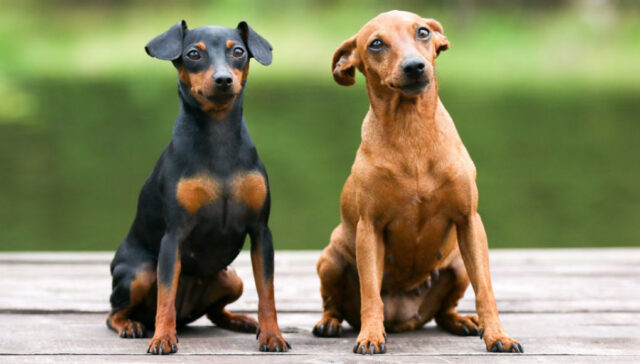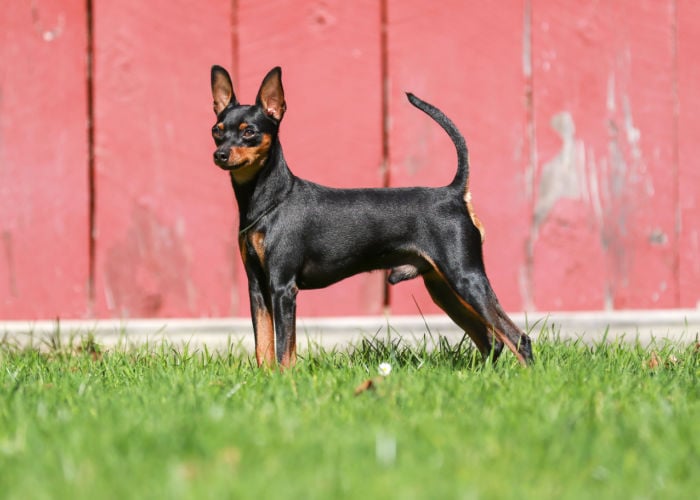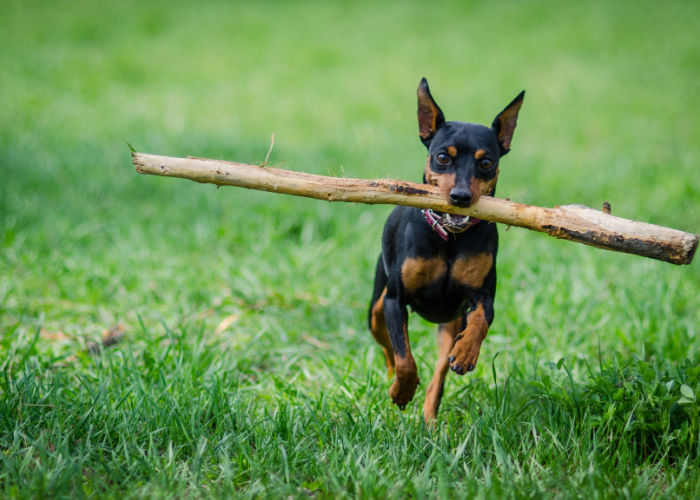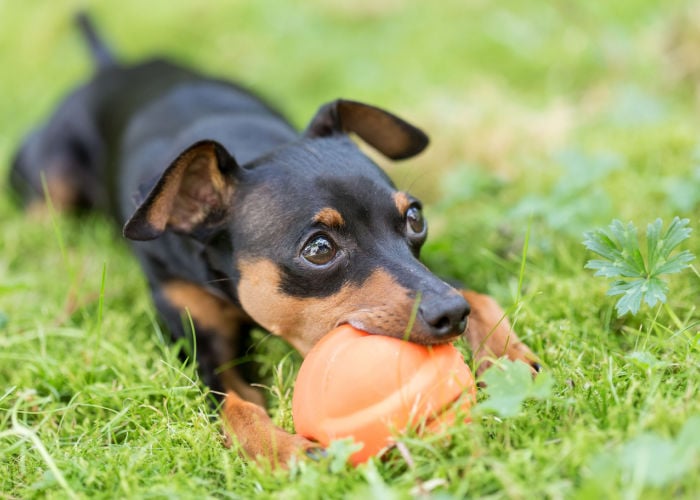
Table of Contents
- Miniature Pinscher Dog Breed Profile
- Living Conditions
- The Miniature Pinscher Dog Personality
- Miniature Pinscher Dog Health
- Mini Pins Life Span
- Brief History of the Miniature Pinscher Dog
- 7 Interesting Facts About the Miniature Pinscher Dog
- 1. Min Pins Are Bred to Hunt Rats
- 2. Miniature Pinschers Are Celebrity Magnets, Too!
- 3. Mini Pinschers Are the Kings of Toys
- 4. Miniature Pinscher Dogs Are Great Escape Artists
- 5. Min Pin Ears Get Cropped For Shows
- 6. Miniature Pinschers Aren’t Related to Dobermans
- 7. Mini Pinscher Dogs Walk Like a Hackney Horse
- Miniature Pinscher Dog Breed: In A Nutshell
The Miniature Pinscher dog is a small pooch that’s packed with a dynamite personality.
Also called Min Pins or Mini Pinschers, this dog breed is a household favorite because of its spirited character and quirkiness.
Considering letting one into your home? Well, we’ve curated this article just for you.
Read on to learn more about:
- The Miniature Pinscher dog’s brief history
- Common illnesses Mini Pinschers suffer from
- Why Min Pins’ ears and tails are usually short
- 7 interesting facts about Miniature Pinscher dogs
- And so much more!
Miniature Pinscher Dog Breed Profile
This dog breed is particularly known for its tough-looking demeanor despite its small body.
They also have distinct dark, oval eyes that actually work when they start to plead but don't let that fool you. There's more to this little doggo than you think!
Here's a quick overview of the physical appearance of Mini Pinschers and what makes them stand out!
Physical Traits of Mini Pinschers
Height and Weight
The Miniature Pinscher dog stands 10 to 12.5 inches and weighs about 8 to 10 pounds.
Upon maturity, a male Mini Pin weighs around 9 to 11 pounds, while the female weighs between 7.7 to 9 pounds but may appear slightly longer.
Body
The Miniature Pinscher dog has a small body with an arched neck.
Despite their miniature size, Mini Pinschers are well-muscled and lean. These traits add up to their confident and leader-like personality.
Eyes and Ears
The Miniature Pinscher dog has dark, oval-shaped eyes and cropped ears. But why do the Miniature Pinscher dog’s ears get cropped?
The Miniature Pinscher dog’s ears get cropped to suit their overall appearance.
Min Pins have long, sometimes floppy or saggy, ears, and some dog owners prefer to crop them to match their proud personalities.
However, ear cropping in dogs is a hot controversy in animal protection organizations around the world today.
In fact, legislation against ear cropping in dogs was passed in some countries, including the following:
- Brazil
- Australia
- Germany
- New Zealand
- Czech Republic
Tail
Miniature Pinscher dogs are born with long tails but are usually seen with docked ones. That’s because Mini Pinscher dogs’ tails are cut off to prevent rodents from biting them.
However, animal enthusiasts regard tail docking as harmful to canine health. This can cause neuroma or nerve tumors in dogs.
Studies also support that dogs communicate emotions and respond to social interactions by wagging their tails.
Coat
The Miniature Pinscher dog’s coat ranges from red to black or a combo of black with rust and chocolate. Their coat is short with a glossy look and has a smooth feel.
Note: Mini Pinschers require minimal grooming, and their coat is easy to care for.
Living Conditions
The Miniature Pinscher dog can be a great apartment buddy because of their small size.
However, Min Pins are active dogs that need exercise and socialization. The earlier they start socializing, the easier for other dogs and pets to get along with them.
Moreover, Miniature Pinscher dogs tend to need—or want—attention.
So, be sure to put them on a leash every time you go out for walks, as they tend to go a little extra.
Note: Training your Mini Pinscher dogs at the earliest time possible can help regulate their tyrant attitude. However, training needs to be consistent, positive, and gentle.
The Miniature Pinscher Dog Personality
The Miniature Pinscher dog is a companion that can rule over you or your household. Despite their small bodies, they have dominant personalities.
It's no wonder that they are considered the “King of Toys.” They are proud and fearless, and Mini Pins tend to be independent, which makes training a bit challenging.
That said, Min Pin owners must be leaders of the pack at all times. Before owning one, you must exert a strong will to rule your mighty Min Pin dogs at home.
However, remember to be loving and kind towards them.
With that, you can start training your Min Pins and be generous with positive reinforcements like treats.
They also need time to socialize and do regular exercises due to their active lifestyle.
Despite their confidence and fearlessness, Mini Pinscher dogs are affectionate towards their owners and family members. They’re great around children, too.
But it's best to have Min Pins around kids who are 10 years older. Still, proper supervision is needed at all times.
What’s more, Mini Pinschers are extremely curious and investigative dogs.
They’re great watchdogs, too. And yes, they may bark a lot. But Min Pins don’t easily fall into a stranger’s trap—whether real or not.
Relevant Read: How To Discipline A Dog Effectively Without Punishment
Miniature Pinscher Dog Health
Despite their active and healthy lifestyle, Miniature Pinscher dogs can sometimes feel under the weather.
And just like other breeds, Mini Pins can be susceptible to certain diseases, including:
Canine Hip Dysplasia
Also known as CHD, canine hip dysplasia is a skeletal disorder that targets the ball and socket joint in the hip, even in small-breed dogs.
Changes or movement around the hip joint often occur during growth in dogs and are caused by the following factors:
- Lack of exercise
- Improper nutrition
- Bone formation process
Moreover, some common symptoms of CHD include:
- Limping
- Weakness
- Hind leg pain
- Difficulty moving
Veterinary experts make continuous efforts to look for treatments for CHD.
To date, the following are known to relieve joint pain in dogs with CHD according to a study:
- Fish oil
- Green-lipped mussels
- Nonsteroidal anti-inflammatory drugs
- Polysulfated glycosaminoglycan supplements
Note: Numerous studies confirm that maintaining a healthy body weight helps prevent or delay hip dysplasia in dogs.
Legg-Calve-Perthes Disease
Legg-Calve-Perthes (LCP) disease is associated with the deterioration of the ball of the femur bone in small-breed dogs.
The femur bone consists of the ball and socket joint that forms the hip. This then causes pain as the hip collapses, sometimes leading to arthritis.
The cause of LCP in dogs is unknown. However, studies show the following possible causes:
- Disruption in the blood vessels
- Abnormal blood flow in the femur bone
Note: Experts study the genetic cause of LCP in dogs. However, this finding is yet to be confirmed.
Moreover, common signs of Legg-Calve-Perthes disease in dogs include:
- Limping
- Leg or joint pain
- Difficulty in moving
Dogs with LCP often lose muscle mass in the affected leg due to non-movement for longer periods.
Furthermore, treatments for Legg-Calve-Perthes disease in dogs include the following:
- Surgery
- Therapy
- Pain medication
Note: Dogs with LCP shouldn’t be subjected to breeding, including their parent dogs. This is to ensure that the disease will not pass on to the offspring.
Relevant Read: 12 Common Health Problems for Small Breeds
Mini Pins Life Span
The Miniature Pinscher dog’s average lifespan ranges between 12-16 years. This depends on several factors, including:
- Diet
- Exercise
- Socialization
- Living Conditions
Brief History of the Miniature Pinscher Dog
The Miniature Pinscher dog originated in Germany and was recognized as a working breed in 1895.
Mini Pinschers were then first presented at the Stuttgart Dog Show in 1900 and since then started gaining popularity, even before and after World War I.
In 1919, Miniature Pinschers were first imported to the US and got recognized by the American Kennel Club 10 years later as a Terrier dog breed.
But in 1930, they were recognized as Toys and renamed Miniature Pinscher in 1972.
Trivia: In German, Min Pins were called Zwergpinscher, where Pinscher refers to dogs and Zwerg for dwarf or small.
7 Interesting Facts About the Miniature Pinscher Dog
1. Min Pins Are Bred to Hunt Rats
The Miniature Pinscher dog is originally bred to hunt vermins or animals that infest crops like rats.
Catching rats in stables and farms, Min Pins are great at sensing whenever these pests are around.
Trivia: Dogs are excellent rat detectors. They have a powerful sense of smell and hearing that they can tell whether a mouse is beyond their radar.
Despite this general observation in dogs, Mini Pinschers are just extremely curious and persistent. They’ll chase their prey until they catch them.
With intense energy and prey drive, there’s no question why your Min Pins at home can get quite messy sometimes.
Relevant Read: 5 Ways to Train a Hyperactive Dog to Calm Down
2. Miniature Pinschers Are Celebrity Magnets, Too!
Hollywood A-list celebrity and socialite Paris Hilton owns quite a great deal of pets — from pigs and ponies to dogs.
Owning mostly Pomeranians and Chihuahuas, Paris Hilton rescued and adopted a Mini Pinscher dog named Dollar in June 2013.
To date, Paris Hilton has had a total of 15 dogs, 20 bunnies, and a few exotic animals like chimpanzees, ferrets, and kinkajous.
Trivia: Paris Hilton owns a $325,000 custom dog mansion in her backyard.
Furthermore, singer-songwriters like Carrie Underwood and Eric Church are fur parents to Min Pin dogs, too.
According to fur dad Eric Church, his Min Pin named Quincy Jones is “vicious” yet has “a mighty heart.”
3. Mini Pinschers Are the Kings of Toys
Well, Miniature Pinschers are called the Kings of Toys for a reason — they’re unapologetically proud.
Belonging to the toy dog group, Mini Pinschers always think they rule despite their humble size (a.k.a. the small dog syndrome).
That said, Min Pins are fearless, energetic, and persistent—all wrapped into one small, sturdy package.
With their outspoken and extroverted nature, we can all agree that Miniature Pinscher dogs deserve the title.
Note: Miniature Pinscher dogs aren’t ideal for new fur parents due to their ‘big boss' character.
However, early training and socialization can help regulate their atomic personality.
Relevant Read: 20 Most Aggressive Dog Breeds
4. Miniature Pinscher Dogs Are Great Escape Artists
Whether you’re leaving for work or talking to the delivery guy, Miniature Pinschers will bolt to your front door like lightning.
While this comes naturally in Min Pin dogs, take extra caution at all times. This could get them into trouble.
And in worse cases, they could get into accidents like the following:
- Incur serious injuries
- Run into a busy road
- Encounter with a predator
You might ask: “Why do Miniature Pinscher dogs escape?”
In general, dogs escape due to the following reasons:
- Isolation
- Boredom
- Sexual roaming
But Mini Pinschers tend to have an independent attitude and a fearless persona. They’ll tend to chase almost anything, even animals that are bigger than them.
Relevant Read: How To Stop A Dog From Escaping: Why It Happens and Escape Artist Behavior
5. Min Pin Ears Get Cropped For Shows
Most dogs get their ears cropped for shows, and Miniature Pinschers are also subjects of this trend.
Let’s find out the whats and whys behind ear cropping in dogs.
What is ear cropping?
Ear cropping is the process of trimming and cutting the dog’s ears, especially the floppy part.
This procedure is usually done when the dog reaches 8-12 weeks old. After cropping, their ears are taped to stay upright in shape, giving them a tougher look.
Why do dog shows require ear cropping?
According to the American Kennel Club (AKC), ear cropping is an “acceptable practice[s] integral to defining and preserving breed character, enhancing good health, and preventing injuries.”
However, the canine community and animal welfare organizations like AVMA critique the statement, noting further that ear cropping poses a danger to dogs, such as:
- Infections
- Healing stage discomforts
- Isolation during the healing stage
- Post reactions from general anesthesia
- Unsuccessful procedures resulting in distorted ear shape
6. Miniature Pinschers Aren’t Related to Dobermans
The Miniature Pinscher dog is often confused with a mini version of the Doberman breed. However, they’re two different breeds.
In fact, the dominant similarity between Min Pins and Dobermans is their link to the Old German Standard Pinscher roots.
Moreover, the Mini Pinscher dog is purebred. And canine experts and historians agree that Min Pins are already several centuries old.
Trivia: The Miniature Pinscher dog is the smallest of the three Pinscher breeds, including the German and Doberman Pinscher.
7. Mini Pinscher Dogs Walk Like a Hackney Horse
One distinctive and cute feature of the Miniature Pinscher dog is its hackney gait.
What does hackney gait in Miniature Pinscher dogs mean?
The hackney gait in Mini Pinscher dogs refers to their high struts, like how a Hackney horse walks.
In context, the Hackney horse is a stylish carriage breed known for their high-stepping trots often seen in shows.
Whenever you see a Min Pin dog doing the hackney gait, you can’t deny the confidence in every strut, adding to their credibility as the Kings of Toys.
Interesting Read: Weirdest Crossbreed Dogs
Miniature Pinscher Dog Breed: In A Nutshell
Getting to know a Miniature Pinscher dog is both exciting and jaw-dropping. That’s because this pooch is definitely a box of surprises.
What’s your favorite Min Pin dog trait?
Ours would be their hackney gait. Min Pin dogs strutting with confidence and pride is a must-watch.
Meanwhile, when you’re contemplating getting a Min Pin puppy, know that the Miniature Pinscher dog has a dynamite personality. They like to rule the pack despite their size.
Min Pin dogs are also great escape artists. Be sure to escape-proof your home as much as you can.
Mini Pinschers are great watchdogs. They’re good family pets, especially those with older kids, and they are quite affectionate to their owners, too.
With consistent training and socialization, you can help regulate their quirky personality in a more tolerable fashion.















